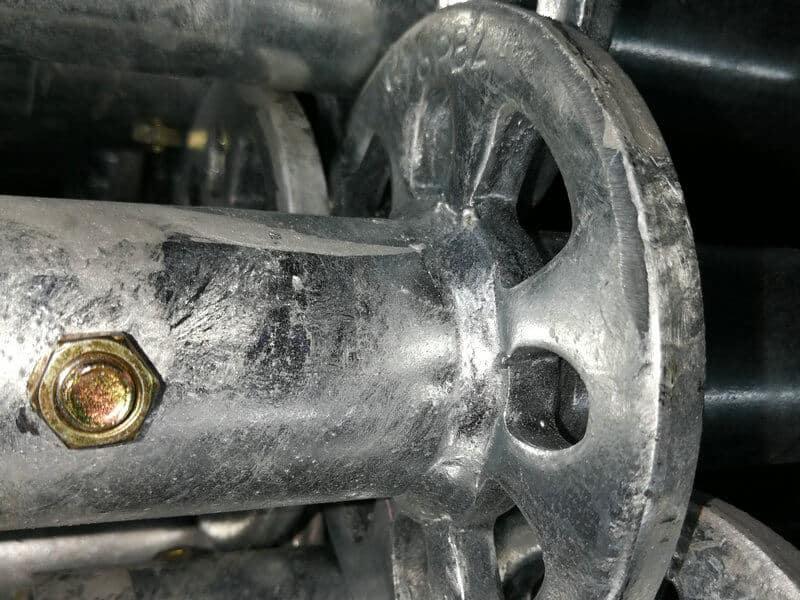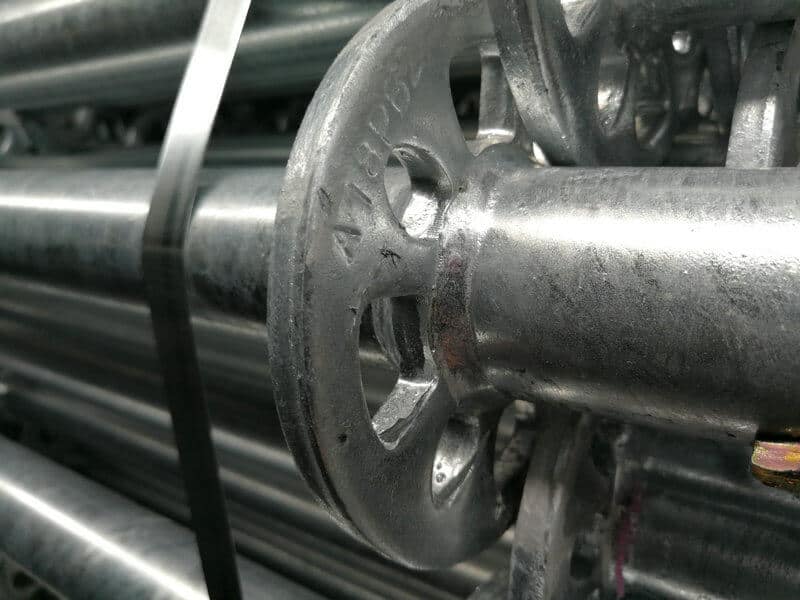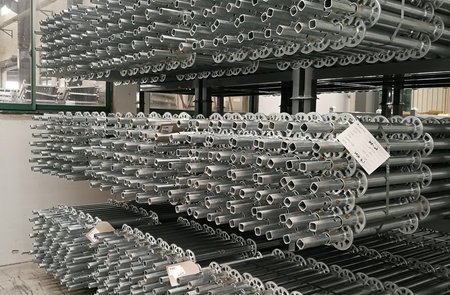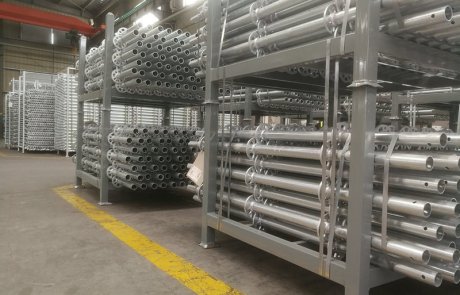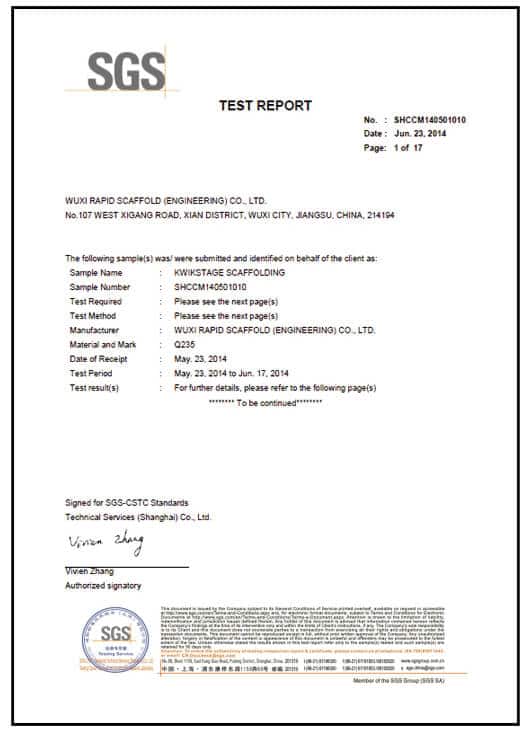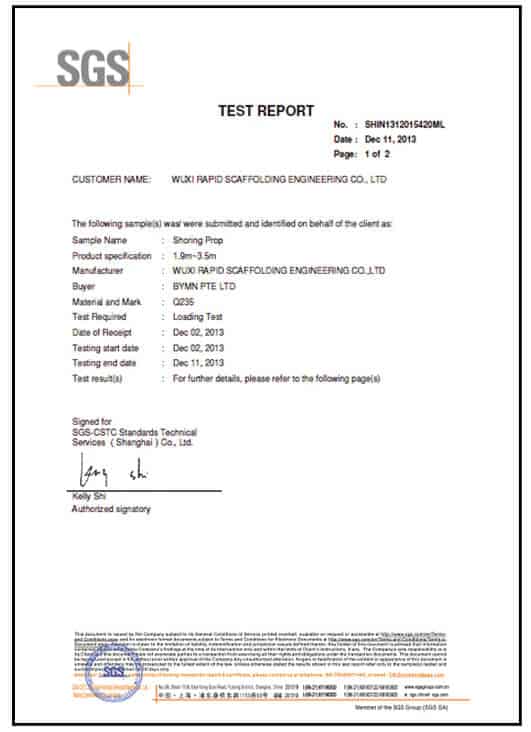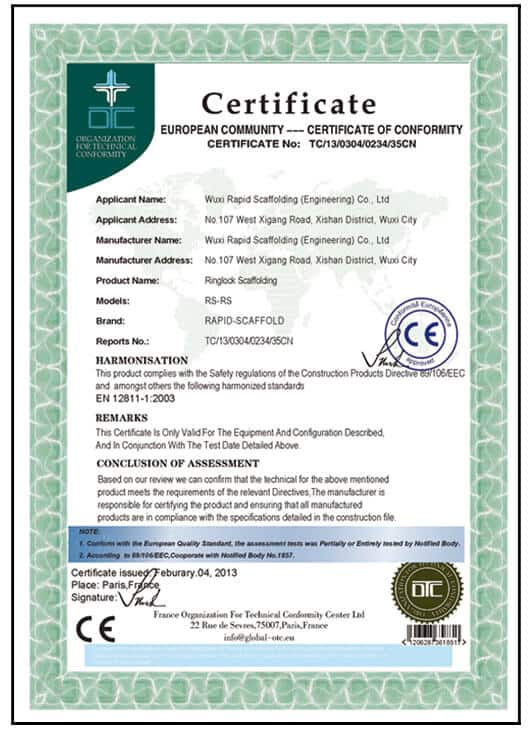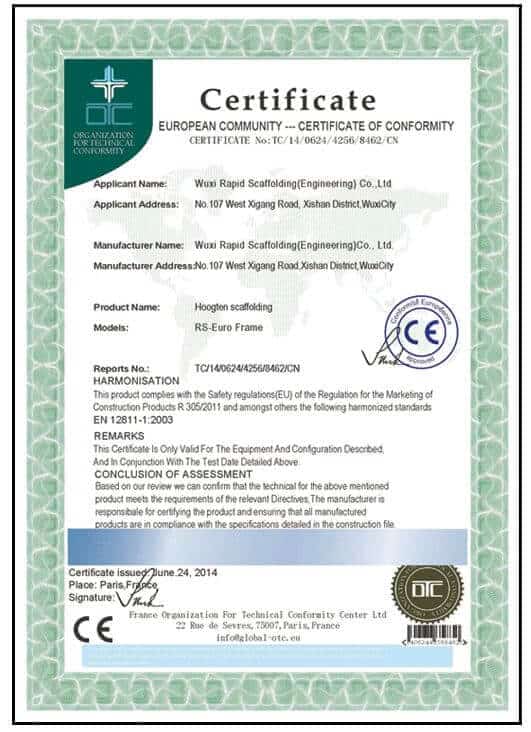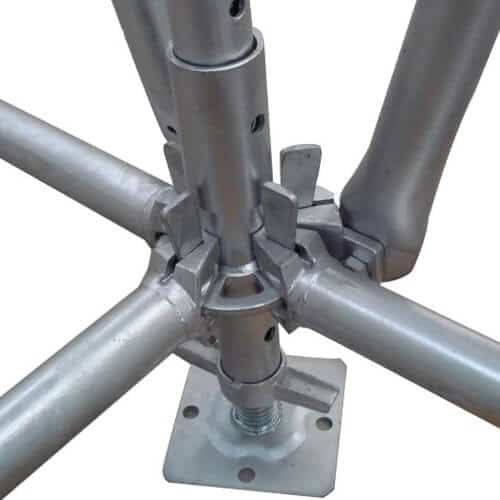
Ringlock Scaffolding
If you are looking for a scaffolding that is safe, stable and easy to use, our ringlock scaffold will be your best choice. Engineering Design, Customized Sizes & Competitive Price Save Your Cost & Time.
Ringlock Scaffold has been widely used in construction sites all over the world. It’s an ideal temporary structure for any height requirement with its high load-bearing capacity. We have focused our business structure to best serve scaffolding companies and contractors, helping them to grow their businesses.
Passed EN & ISO 9001 certifications. Owning our own factory & testing laboratory and employing several hundred skilled factory workers helps us to remain competitive in the scaffolding market. All of these factors together have allowe TOTAL CONTEC to be one of the largest scaffolding suppliers in China.
So what are you waiting for? Get yours today!
Ringlock Scaffolding Details
Total Contec’s ringlock is also called ringlock scaffolding, one of the system scaffolding,or modular scaffolding.
It is widely used in the construction industry, such as building, bridge, viaduct, petrochemical, etc. It supports to access work and platform as a temporary structure in building construction and also plays a heavy load duty in many kinds of project.
Compared to tube and clamps, it installs without any screw bolts and nuts, only with wedge lock connections, so that is very easy to assemble and disassemble.
The ringlock scaffolding mainly consists of standard or vertical, ledger, diagonal brace, and components such as base collar, head jack, base jack.
It can be simple and convenient to meet most requirements of temporary structure and access assisted with steel plank and kinds of bracket.
Total Contec has supplied the product to many famous companies of scaffolding and access industries. Our products’ quality has been verified by customers and time.

Ringlock Standard
Tube diameter: 48.3mm, thickness: 3.2mm, Steel Grade: Q345, Surface treatment: Hot dip galvanized
| Product | Length | ||
| Code | Description | Inches | Meters |
| RLS500 | 1 Ring standard w/spigot | 19.69 | 0.5 |
| RLS1000 | 2 Ring standard w/spigot | 39.37 | 1.0 |
| RLS1500 | 3 Ring standard w/spigot | 59.06 | 1.5 |
| RLS2000 | 4 Ring standard w/spigot | 78.74 | 2.0 |
| RLS2500 | 5 Ring standard w/spigot | 98.43 | 2.5 |
| RLS3000 | 6 Ring standard w/spigot | 118.11 | 3.0 |

Ringlock Ledger
Tube diameter: 48.3mm, thickness: 3.2mm, Steel Grade: Q345, Surface treatment: Hot dip galvanized
| Product | Length | ||
| code | description | Inches | Meters |
| RLL073 | 2′-4″ Ledger | 28.82 | 0.73 |
| RLL1090 | 3′-6″ Ledger | 42.83 | 1.09 |
| RLL1290 | 4′-3″ Ledger | 50.63 | 1.29 |
| RLL1570 | 5′-2″ Ledger | 61.88 | 1.57 |
| RLL2070 | 6′-9″ Ledger | 81.5 | 2.07 |
| RLL2570 | 8′-6″ Ledger | 101.3 | 2.57 |
| RLL3070 | 10′-1″ Ledger | 121 | 3.07 |

Ringlock Diagonal Brace
Tube diameter: 48.3mm, thickness: 2.5mm, Steel Grade: Q235, Surface treatment: Hot dip galvanized
| Product | Width | Length | |||
| Code | Description | Inches | Meters | Inches | Meters |
| RLDB2120 | 2′-4″ Diagonal Brace | 28.82 | 0.73 | 78.74 | 2 |
| RLDB2250 | 3′-6″ Diagonal Brace | 42.83 | 1.09 | 78.74 | 2 |
| RLDB2350 | 4′-3″ Diagonal Brace | 50.63 | 1.29 | 78.74 | 2 |
| RLDB2490 | 5′-2″ Diagonal Brace | 61.88 | 1.57 | 78.74 | 2 |
| RLDB2810 | 6′-9″ Diagonal Brace | 81.5 | 2.07 | 78.74 | 2 |
| RLDB3180 | 8′-6″ Diagonal Brace | 101.3 | 2.57 | 78.74 | 2 |
| RLDB3580 | 10′-1″ Diagonal Brace | 121 | 3.07 | 78.74 | 2 |

Ringlock Bridge Ledger
Tube diameter: 48.3mm, thickness: 3.2mm, Steel Grade: Q235, Surface treatment: Hot dip galvanized
| Product | Length | ||
| code | description | Inches | Meters |
| RLBL1570 | 5′-2″ Bridge Ledger | 61.88 | 1.57 |
| RLBL2070 | 6′-9″ Bridge Ledger | 81.5 | 2.07 |
| RLBL2570 | 8′-6″ Bridge Ledger | 101.3 | 2.57 |
| RLBL3070 | 10′-1″ Bridge Ledger | 121 | 3.07 |

Ringlock Lattice Ggirder
Tube diameter: 48.3mm, thickness: 3.2mm, Steel Grade: Q235, Surface treatment: Hot dip galvanized
| Product | Length | ||
| code | description | Inches | Meters |
| RLLG1570 | 5′-2″ Lattice Girder | 61.88 | 1.57 |
| RLLG2070 | 6′-9″ Lattice Girder | 81.5 | 2.07 |
| RLLG2570 | 8′-6″ Lattice Girder | 101.3 | 2.57 |
| RLLG3070 | 10′-1″ Lattice Girder | 121 | 3.07 |
| RLLG4140 | 13′-7″ Lattice Girder | 163 | 4.14 |
| RLLG5140 | 16′-10″ Lattice Girder | 202.4 | 5.14 |
| RLLG5141 | 20′-2″ Lattice Girder | 242 | 6.14 |
| RLLG5142 | 25′-3″ Lattice Girder | 303.5 | 7.71 |
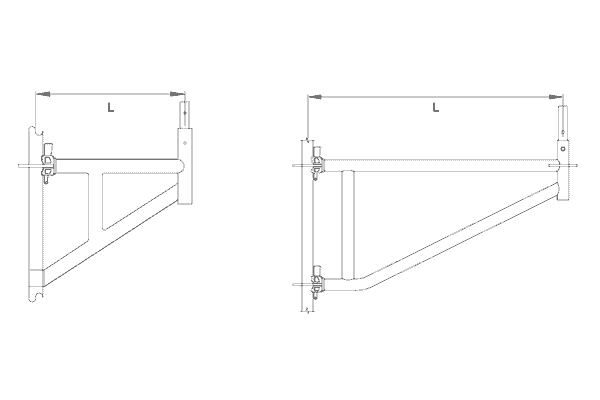
Ringlock Board Bracket
Tube diameter: 48.3mm, thickness: 3.2mm, Steel Grade: Q235, Surface treatment: Hot dip galvanized
| Product | Length | ||
| code | description | Inches | Meters |
| RLBB360 | 1′-2″ Board Bracket | 14.17 | 0.36 |
| RLBB390 | 1′-3″ Board Bracket | 15.35 | 0.39 |
| RLBB730 | 2′-4″ Board Bracket | 28.82 | 0.73 |
| RLBB1090 | 3′-6″ Board Bracket | 42.83 | 1.09 |

Ringlock Base Collar
Tube size: 48.3×3.2mm & 57×2.5mm. Surface treatment: Hot dip galvanized
| Product | Length | ||
| code | description | Inches | Meters |
| RLBC200 | Base Collar | 7.87 | 0.2 |

Ringlock Caster Adapter
| Product | Length | ||
| code | description | Inches | Meters |
| RLCA300 | Caster Adapter | 12.13 | 0.3 |
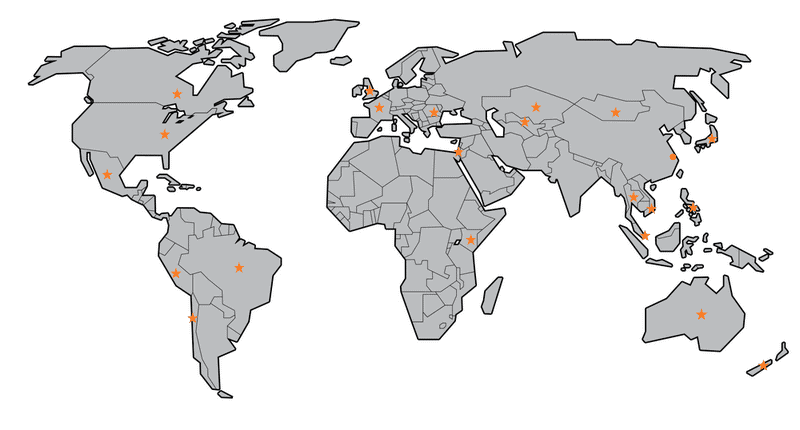
Total Contec Ringlock Scaffolding Video
FAQ About Ringlock Scaffolding
Ringlock scaffolding is one, if not the most used type of scaffolding system in the market. It has a ton of great benefits, advantages, but it has certain drawbacks as well.
In this FAQ guide, we will be detailing everything you need to know about ringlock scaffolding. Not only that, but we will also try and compare it with other types of scaffolding so that you grow aware of what specific scaffolding system will be better for you.
Contents
- Price information of your concern will be sent your email in 24 hours!
- Ringlock Standard
- Ringlock Ledger
- Ringlock Diagonal Brace
- Ringlock Bridge Ledger
- Ringlock Lattice Ggirder
- Ringlock Board Bracket
- Ringlock Base Collar
- Ringlock Caster Adapter
- Total Contec Ringlock Scaffolding Video
- FAQ About Ringlock Scaffolding
- Understanding What Ringlock Scaffolding Is
- What Size is Standard Scaffolding?
- What Are the Three (3) Different Types of Scaffolds?
- Aerial Lifts
- Supported Scaffolds
- Suspended Scaffolds
- Ringlock vs. Cuplock Scaffolding Systems
- What is a Rosette Connector?
- What Materials Are Used For Scaffolding?
- Ringlock Scaffolding Parts Names
- Standards and/or Verticals
- Ledgers
- Diagonal Braces
- Truss Ledgers
- Side Brackets
- Steel Planks
- Lattice Girders
- What is Rosette Scaffolding?
- How Do You Install Ringlock Scaffolding?
- Pros of Ringlock Scaffolding
- Fast Erection and Installation
- Reduced Work Time
- High-Bearing Loads
- Reduced Errors
- Space-Saving
- Flexibility and Versatility
- Why is Ringlock Scaffolding Popular?
- Who is the Best Company For Your Ringlock Scaffolding Needs?
- Reasons to Go With Total Contec
- Total Contec Advantages
Understanding What Ringlock Scaffolding Is
Ringlock scaffolding is a type of modular scaffolding that’s built and designed for industrial and heavy construction applications. It’s under the category of robust scaffolding because of how it’s put up, the components that it has, and the overall functionality of it.
DID YOU KNOW: Ringlock scaffolding is also called as LAYHER scaffolding because LAYHER, a German company, came up with the idea of it.
What Size is Standard Scaffolding?
There is actually no “standard” or “regular” size in scaffolding. The size that would be standard will depend on the type, size, and the quality of project you’ll be working on.
However, the common sizes of scaffolding usually revolve around 8, 9, 12, and 16 feet in length.
What Are the Three (3) Different Types of Scaffolds?
As per the Occupational Safety and Health Administration (OSHA), the three (3) main types and categories of scaffolds are Aerial Lifts, Supported Scaffolds, and Suspended Scaffolds.
Aerial Lifts
These are the simplest and most basic forms of scaffolding. It utilizes a vehicle with a platform, and is used to elevate or “lift” workers or personnel at a certain height. Aerial lifts vary from one category to another, but the most common types of aerial lifts include, but are not limited to:
- Aerial Ladders
- Articulating Booms (Boom Platforms)
- Extendable Booms (Boom Platforms)
- Vertical Towers
NOTE: Aerial lifts can also be comprised with the combination of any of these types.
Supported Scaffolds
Supported scaffolds, on the contrary, are scaffolds that are built and designed to reach a certain height that would befit the project. Similar to aerial lifts, supported scaffolds are also categorized into different basic types, namely:
- Frame Scaffolding
- Mobile Scaffolding
- Pole and/or Wood Scaffolding
- Specialty Scaffolding
- Tube and Couper Scaffolding
Suspended Scaffolds
Last but most definitely not least are suspended scaffolds. These are scaffolding structures that are suspended in the air, rather than being supported from a base. Usually, they are suspended using non-rigid means like ropes or other overhead structures.
Different types of suspended scaffolds include the following:
- Single-Point Adjustable
- Two-Point Adjustable (Swing Stage)
- Multi-Point Adjustable
- Catenary
- Float
- Interior Hung
- Multi-Level
- Needle Beam
These are the most basic classifications and types of scaffolding as per OSHA.
Not seeing ringlock? Well, that is because ringlock is a type of tube and coupler scaffolding.
Ringlock vs. Cuplock Scaffolding Systems
Both scaffolding categories carry the same weight, and both of them have similar end-goals. But how do these scaffolding structures differ? What makes them unique from one another?
Ringlock, or also known as K-Ring scaffolding is designed to be more efficient than its predecessor, cuplock. It is a type of scaffolding that utilizes a pipe that’s self-locking using a rosette connector.
Cuplock scaffolding, or also known as the K-Lock, is a scaffolding category that utilizes metal cups for the purpose of holding and locking beams, ledgers, and standards altogether.
One major advantage that Ringlock has over cuplock is the lightweight of materials. Instead of using metal cups, rings or rosettes are what’s used to intertwine and conjoin components together. The drawback that ringlock has over cuplock would be the maintenance of the parts (nuts, bolts, and threads).
What is a Rosette Connector?
A rosette connector is a type of connector that takes the shape and form of a “rose.” Do take note, though, that ringlock scaffolding doesn’t necessarily use a full-on rosette connector, just a similar type.
Don’t confuse yourself about rosettes and ringlocks. The only reason why the term “rosette” is used would be because of its shape.
What Materials Are Used For Scaffolding?
Various scaffolding manufacturers and service providers make use of a wide library of products for the establishment of their scaffolding structures.
Commonly, though, manufacturers and suppliers make use of the following materials for scaffolding parts and components:
- Wood
- Aluminum
- Steel (Galvanized Steel)
- Fiber Glass
NOTE: Galvanized steel remains as the widely-known material for the construction and development of scaffolding systems because of how durable, versatile, and extremely flexible they are compared to other materials.
Ringlock Scaffolding Parts Names
Of course, there need be components to make up the entirety of a Ringlock scaffolding structure. Similar to most types and categories of scaffolding, the names and terms are greatly similar, if not entirely similar to one another.
Standards and/or Verticals
Standards are what’s considered as the most relevant component in a ringlock scaffolding system because it is the one that serves as a connection point for all other components. Without a standard, you wouldn’t be able to connect ledgers to brackets, and many other components.
Ledgers
Ledgers are the components that bring standards together, making sure that they’re just right far from each other. It’s used by connecting it at two (2) ends of each of the standards so they become conjoined.
Diagonal Braces
Many people think that diagonal braces are similar to ledgers, and are just positioned diagonally. However, that’s not entirely true. Yes, they’re manufactured the same as ledgers, but instead of having it in the same way, the ends are welded and made with a diagonal plug.
Truss Ledgers
Truss ledgers are components that have been designed to allow higher loads to the scaffolding system. It’s like added support at the top tube so that it can carry more force, stress, and weight without experiencing shakiness on the scaffolding system.
Side Brackets
These are what’s considered as extensions of a scaffolding system. Usually positioned at the end of a scaffolding system, the purpose of side brackets would be to widen the overall area of the steel planks for a more flexible working environment for the personnel.
Steel Planks
The steel planks are the parts or components that are used as the working space or area of the workers or the personnel. Steel planks are typically fixated and installed on the ledger so that the workers wouldn’t have trouble slipping or sliding through it.
NOTE: The surface part of steel planks are usually coated with a non-stick coating.
Lattice Girders
These are also used for support or added weight on the platforms. This is what enables scaffolding systems to carry and hold twice the weight they were originally made for!
NOTE: You will also find other or secondary components in the names and labels of wood toe boards, steel stairs, transoms, collars, and others!
What is Rosette Scaffolding?
We already know what a rosette is, but what about its place in the scaffolding environment?
For the simplest, most basic, and easiest way to identify it, rosette scaffolding is a type of modular scaffolding where rosettes are what’s used for the connection of the components.
Many experts view this as an excellent alternative to ringlock scaffolding because of how easy, simple, and fast it is to set up!
How Do You Install Ringlock Scaffolding?
The installation procedure of ringlock scaffolding is just like any other type of tubular and coupler scaffolding. For the benefit of everyone, including beginners or those who don’t have the necessary experience to absorb all these, here’s a brief step-by-step procedure of installing or setting up ringlock scaffolding:
- The base jacks are positioned out on the ground for the preparation of all other components.
- Then, the base collar is added. This serves as the male/female part of the jack to the ledger.
- Once the ledger is installed and placed, the steel plank will be put to the formula.
- When the first level of the scaffolding is complete, the standards are assembled into the base collar.
- Through the inlets of the standard, several ledgers would be added to form the 2nd, 3rd, 4th, or whatever level the scaffolding requires.
This is the basic way of how ringlock scaffolding systems are positioned and installed.
DISCLAIMER: Not all businesses and companies follow the same method. What we gave you is simply the general outline of how ringlock scaffolding systems are put up and established.
Pros of Ringlock Scaffolding
There are quite a few benefits and advantages to using ringlock scaffolding. And to enumerate the most common and most notable ones, they include:
Fast Erection and Installation
Probably one of the biggest advantages and pros of ringlock scaffolding is its property of being fast-installed and fast-erected. Because all parts and components would already be conjoined, you rarely need to plan out how you would connect, attach, and fuse all parts and components together.
This saves you a lot of time and a lot of effort in erecting it.
Reduced Work Time
This is what follows the fast installation and erection of a ringlock scaffolding system. All systems need to be erected (unless if it’s aerial lifts) and therefore, you’ll be doing yourself a huge favor with ringlock scaffolding systems because you wouldn’t worry about longer hours in fixating, establishing, and erecting it.
High-Bearing Loads
If you’re worried about weight, pressure, and force – then, don’t! Ringlock scaffolding systems are built and designed to withstand loads that are more than the recommended. In case you forgot, most of the components are crafted using high-quality galvanized steel, which serves both style & design, as well as functionality.
Reduced Errors
Errors are rampant in the scaffolding industry, and this is what ringlock scaffolding systems addressed. Their design is intended to make sure that workers, assemblers, and even engineers are looking at the same page.
This doesn’t only make assembly and disassembly faster, but also cleaning and replacement! It’s an absolutely efficient scaffolding system!
Space-Saving
Since the components blend well with one another, storing them wouldn’t be a problem for you, not to mention that transporting and moving the parts from one place to another won’t require much manpower also since the material is lightweight and there would be no added weight for unnecessary components.
Flexibility and Versatility
Last would be its flexibility. Ringlock scaffolds are known to be used by a lot of sectors and industries, not only in the residential and commercial building space. It’s also used for roadwork, demolition, renovation, and many other projects.
If you think ringlock scaffolding is just like one of the other types of scaffolding systems out there, think again!
Why is Ringlock Scaffolding Popular?
It could be late to ask this, but what do you think is the main reason why ringlock scaffolding is considered as one of the best types of scaffolding systems in the market?
Well, there are many reasons, but the most common would be because of the fact that it’s usable in every industry or application you can think of.
Ringlock scaffolding systems are scattered worldwide, and are used for many different projects. The most common ones are:
- Subways and Trains
- Dams
- Residential and Business Properties
- Ships and Shipyards
- Repair and Renovation
- And Many More!
Who is the Best Company For Your Ringlock Scaffolding Needs?
For the best and most reliable ringlock scaffolding requirements you have, Total Contec is here! Since 1994, our goal has been the same – and that is to produce the best and highest quality of scaffolding requirements to our clients in and around the country.
For almost 2 decades, we have evidently dominated the market by producing quality sets of ringlock scaffolding parts, installing and establishing the specific scaffolding, and many more!
Not only are we certified, but we are also employed with some of the industry’s most talented, most skilled, and most experienced engineers to do the job.
Reasons to Go With Total Contec
Our ringlock scaffolding expertise is known in the entire country. In fact, it is one of the most, if not the most-sold and most-sought-after types of scaffolding system we have in our pocket!
Other than our ringlock scaffolding products and services, you can also bank on us if you need help with steel ladders, cuplock scaffolding, haki scaffolding, aluminum scaffolds, and many more!
We’ve been servicing both private and public entities for the growth and the development of their construction projects. Reach out to us and receive a quotation for the products and/or services you think would benefit your project or your business!
Total Contec Advantages
- More than 20 years of experience in the construction industry
- Match the optimal and most economical procurement plan according to customer needs.
- Leaders in the field of scaffolding
- One-stop service provider in the field of building materials
- The three major factories guarantee quality, quantity and delivery time
- The technical team has more than 50 people, which can provide various 2D and 3D design solutions
- After-sales service is guaranteed, and online and on-site training guidance for scaffolding and formwork can be provided.

